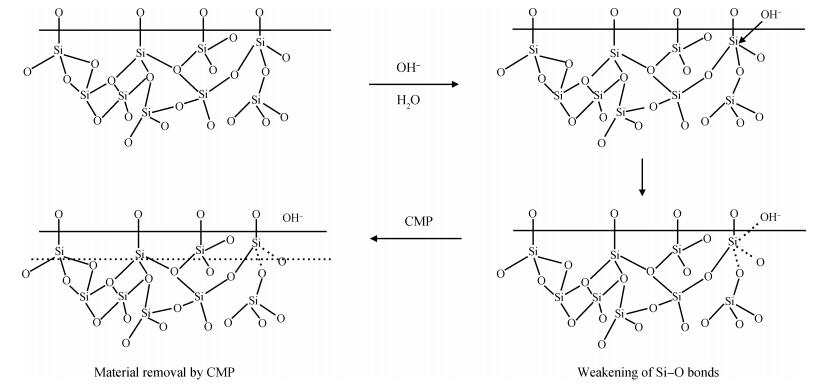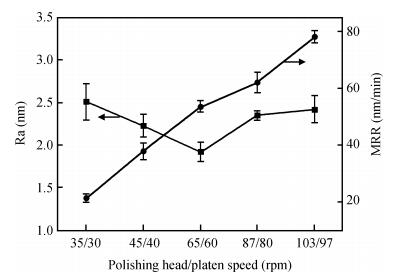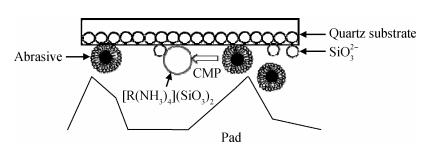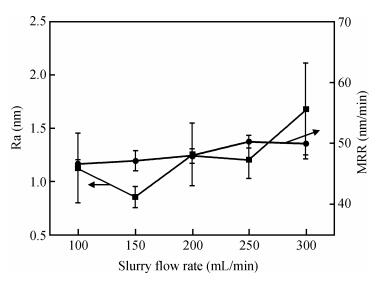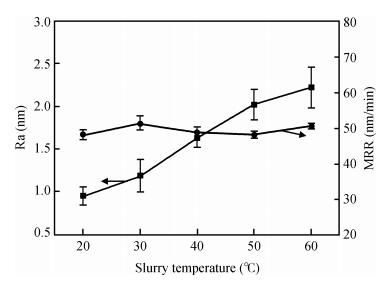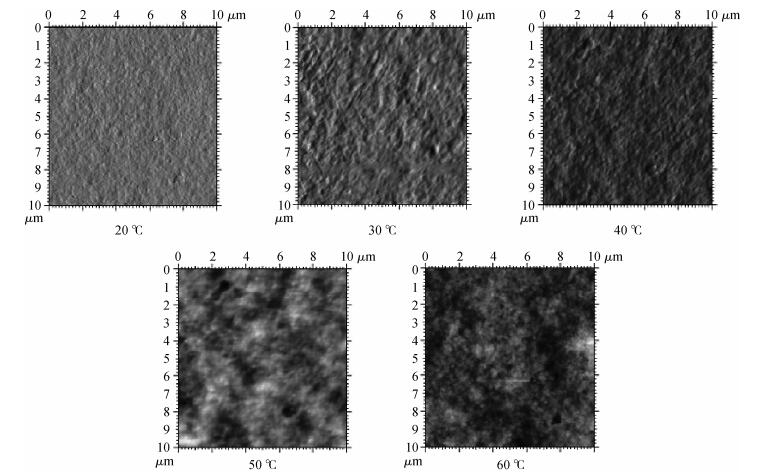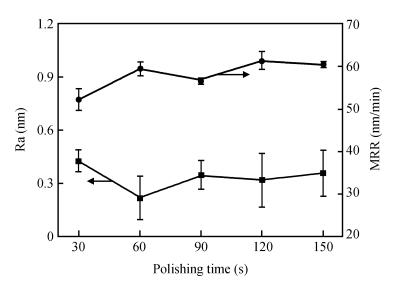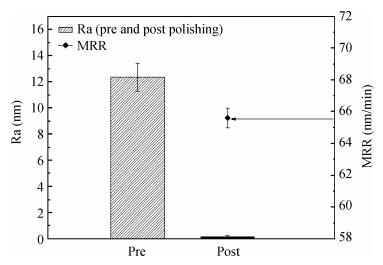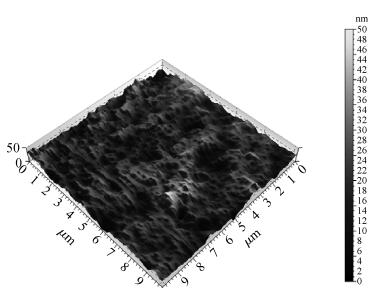| Citation: |
Bo Duan, Jianwei Zhou, Yuling Liu, Mingbin Sun, Yufeng Zhang. Surface roughness of optical quartz substrate by chemical mechanical polishing[J]. Journal of Semiconductors, 2014, 35(11): 116001. doi: 10.1088/1674-4926/35/11/116001
****
B Duan, J W Zhou, Y L Liu, M B Sun, Y F Zhang. Surface roughness of optical quartz substrate by chemical mechanical polishing[J]. J. Semicond., 2014, 35(11): 116001. doi: 10.1088/1674-4926/35/11/116001.
|
Surface roughness of optical quartz substrate by chemical mechanical polishing
DOI: 10.1088/1674-4926/35/11/116001
More Information
-
Abstract
In order to achieve a high-quality quartz glass substrate and to improve the performance of TiO2 anti-reflection coating, chemical mechanical polishing (CMP) method was used. During CMP process, some process parameters including pressure, polishing head speed, platen speed, slurry flow rate, polishing time, and slurry temperature were optimized to obtain lower quartz surface roughness. According to the experiment results, when pressure was 0.75 psi, polishing head speed was 65 rpm, platen speed was 60 rpm, slurry flow rate 150 mL/min, slurry temperature 20℃, and polishing time was 60 s, the material removal rate (MRR) was 56.8 nm/min and the surface roughness (Ra) was 1.93 Å (the scanned area was 10×10 μm2). These results were suitable for the industrial production requirements.-
Keywords:
- quartz substrate,
- surface roughness,
- removal rate,
- CMP,
- process parameters
-
References
[1] Yao J J, Xu C, Ma J Y, et al. Effects of deposition rates on laser damage threshold of TiO2/SiO2 high reflectors. Appl Surf Sci, 2009, 255(9):4733 doi: 10.1016/j.apsusc.2008.08.072[2] Wang Z G, Long X W, Wang F. Bias characteristics of a multioscillator ring laser gyro with consideration of differential losses. Optics & Laser Technology, 2013, 48:285 http://www.sciencedirect.com/science/article/pii/S0030399212004963[3] Umehara N, Kirtane T, Gerlick R, et al. A new apparatus for finishing large size/large batch silicon nitride (Si3N4) balls for hybrid bearing applications by magnetic float polishing (MFP). International Journal of Machine Tools and Manufacture, 2006, 46(2):151 doi: 10.1016/j.ijmachtools.2005.04.015[4] Wang Chenwei, Liu Yuling, Tian Jianyin, et al. Planarization properties of an alkaline slurry without an inhibitor on copper patterned wafer CMP. Journal of Semiconductors, 2012, 33(11):116001 doi: 10.1088/1674-4926/33/11/116001[5] Dettoni F, Rivoire M, Gaillard S, et al. High resolution nanotopography characterization at die scale of 28 nm FDSOI CMOS front-end CMP processes. Microelectron Eng, 2014, 113:105. doi: 10.1016/j.mee.2013.08.001[6] Vasilev B, Bott S, Rzehak R, et al. A method for characterizing the pad surface texture and modeling its impact on the planarization in CMP. Microelectron Eng, 2013, 104:48 doi: 10.1016/j.mee.2012.10.007[7] Furuya T, Wu Y, Nomura M, et al. Fundamental performance of magnetic compound fluid polishing liquid in contact-free polishing of metal surface. Journal of Materials Processing Technology, 2008, 201(1-3):536 doi: 10.1016/j.jmatprotec.2007.11.299[8] Zoethout E, Louis E, Bijkerk F. Real-space insight in the nanometer scale roughness development during growth and ion beam polishing of molybdenum silicon multilayer films. Appl Surf Sci, 2013, 285(Part B):293[9] Anopchenko A, Jergel M, Majková E, et al. Effect of substrate heating and ion beam polishing on the interface quality in Mo/Si multilayers-X-ray comparative study. Physica B:Condensed Matter, 2001, 305(1):14 doi: 10.1016/S0921-4526(01)00589-0[10] Lee H S, Jeong H D. Chemical and mechanical balance in polishing of electronic materials for defect-free surfaces. CIRP Annals-Manufacturing Technology, 2009, 58:485 doi: 10.1016/j.cirp.2009.03.115[11] Lee H S, Jeong H D, Dornfeld D A. Semi-empirical material removal rate distribution model for SiO2 chemical mechanical polishing (CMP) processes. Precision Engineering, 2013, 37:483 doi: 10.1016/j.precisioneng.2012.12.006[12] Hed P P, Edwards D F. Optical glass fabrication technology:relationship between surface roughness and subsurface damage. Appl Opt, 1987, 26(21):4677 doi: 10.1364/AO.26.004677[13] He Xingyang, Su Ying. Machined surface microstructure of optical silica glasses. Journal of Wuhan University of Technology, 2010, 32(13):34[14] Li Y, Hou J, Xu Q, et al. The characteristics of optics polished with a polyurethane pad. Opt Express, 2008, 16:10285 doi: 10.1364/OE.16.010285[15] Wei Wenhao, Liu Yuling, Wang Chenwei, et al. Study of a novel alkaline barrier slurry applied in copper chemical mechanical planarization. Journal of Functional Materials, 2012, 43(23):3333 -
Proportional views





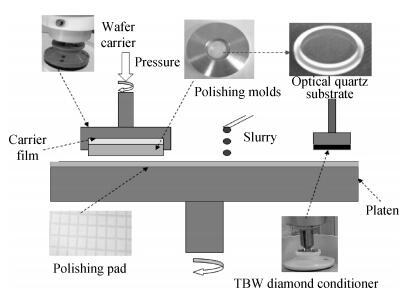
 DownLoad:
DownLoad:


